Binary classification on Titanic Dataset
This is a classic dataset used in many data mining tutorials and demos – perfect for getting started with exploratory analysis and building binary classification models to predict survival.
Data covers passengers only, not crew.
import numpy as np
import pandas as pd
import seaborn as sns
import matplotlib.pyplot as plt
from sklearn.preprocessing import LabelEncoder
from sklearn.model_selection import train_test_split
from sklearn.linear_model import LogisticRegression
from sklearn.metrics import mean_absolute_error, accuracy_score
from sklearn.preprocessing import StandardScaler
df=pd.read_csv(r"D:\Learning\DLithe-ML\Assignment\titanic.csv")
df.shape
(891, 15)
df.info()
<class 'pandas.core.frame.DataFrame'>
RangeIndex: 891 entries, 0 to 890
Data columns (total 15 columns):
# Column Non-Null Count Dtype
--- ------ -------------- -----
0 survived 891 non-null int64
1 pclass 891 non-null int64
2 sex 891 non-null object
3 age 714 non-null float64
4 sibsp 891 non-null int64
5 parch 891 non-null int64
6 fare 891 non-null float64
7 embarked 889 non-null object
8 class 891 non-null object
9 who 891 non-null object
10 adult_male 891 non-null bool
11 deck 203 non-null object
12 embark_town 889 non-null object
13 alive 891 non-null object
14 alone 891 non-null bool
dtypes: bool(2), float64(2), int64(4), object(7)
memory usage: 92.4+ KB
Data cleaning
# Drop duplicate values
df=df.drop_duplicates()
df.shape
(784, 15)
df.isnull().sum()
survived 0
pclass 0
sex 0
age 106
sibsp 0
parch 0
fare 0
embarked 2
class 0
who 0
adult_male 0
deck 582
embark_town 2
alive 0
alone 0
dtype: int64
‘deck’ is mostly empty so we will drop it in the next step.
Age has 106 null values
embarked and embark_town has 2 null values
# Drop columns which are not needed for our analysis or which are duplicates (another column with values meaning the same)
df=df.drop(["deck", "embarked", "adult_male", "alive", "class"], axis=1)
‘deck’ consists of crew data which is excluded in this dataset.
‘embarked’ consists of abbreviated values of ‘embark_town’
‘adult_male’ can be analysed from ‘who’ column; since only a man has adult_male value as 1
‘alive’ is a duplicate of ‘survived’
‘class’ is the textual representation of ‘pclass’
df.head(10)
| survived | pclass | sex | age | sibsp | parch | fare | who | embark_town | alone | |
|---|---|---|---|---|---|---|---|---|---|---|
| 0 | 0 | 3 | male | 22.0 | 1 | 0 | 7.2500 | man | Southampton | False |
| 1 | 1 | 1 | female | 38.0 | 1 | 0 | 71.2833 | woman | Cherbourg | False |
| 2 | 1 | 3 | female | 26.0 | 0 | 0 | 7.9250 | woman | Southampton | True |
| 3 | 1 | 1 | female | 35.0 | 1 | 0 | 53.1000 | woman | Southampton | False |
| 4 | 0 | 3 | male | 35.0 | 0 | 0 | 8.0500 | man | Southampton | True |
| 5 | 0 | 3 | male | NaN | 0 | 0 | 8.4583 | man | Queenstown | True |
| 6 | 0 | 1 | male | 54.0 | 0 | 0 | 51.8625 | man | Southampton | True |
| 7 | 0 | 3 | male | 2.0 | 3 | 1 | 21.0750 | child | Southampton | False |
| 8 | 1 | 3 | female | 27.0 | 0 | 2 | 11.1333 | woman | Southampton | False |
| 9 | 1 | 2 | female | 14.0 | 1 | 0 | 30.0708 | child | Cherbourg | False |
df["age"].describe()
count 678.000000
mean 29.869351
std 14.759076
min 0.420000
25% 20.000000
50% 28.250000
75% 39.000000
max 80.000000
Name: age, dtype: float64
# Fill the empty values in 'age' column to the mean value of age
print('Replacing null values with mean value : ', int(df["age"].mean()))
df["age"] = df["age"].fillna(int(df["age"].mean()))
df.head(10)
Replacing null values with mean value : 29
| survived | pclass | sex | age | sibsp | parch | fare | who | embark_town | alone | |
|---|---|---|---|---|---|---|---|---|---|---|
| 0 | 0 | 3 | male | 22.0 | 1 | 0 | 7.2500 | man | Southampton | False |
| 1 | 1 | 1 | female | 38.0 | 1 | 0 | 71.2833 | woman | Cherbourg | False |
| 2 | 1 | 3 | female | 26.0 | 0 | 0 | 7.9250 | woman | Southampton | True |
| 3 | 1 | 1 | female | 35.0 | 1 | 0 | 53.1000 | woman | Southampton | False |
| 4 | 0 | 3 | male | 35.0 | 0 | 0 | 8.0500 | man | Southampton | True |
| 5 | 0 | 3 | male | 29.0 | 0 | 0 | 8.4583 | man | Queenstown | True |
| 6 | 0 | 1 | male | 54.0 | 0 | 0 | 51.8625 | man | Southampton | True |
| 7 | 0 | 3 | male | 2.0 | 3 | 1 | 21.0750 | child | Southampton | False |
| 8 | 1 | 3 | female | 27.0 | 0 | 2 | 11.1333 | woman | Southampton | False |
| 9 | 1 | 2 | female | 14.0 | 1 | 0 | 30.0708 | child | Cherbourg | False |
# Drop rows with empty (null) values
df=df.dropna()
Exploring the Data
a = ['survived', 'pclass', 'sex','sibsp', 'parch', 'who', 'embark_town', 'alone']
b = ['age', 'fare']
for i in a:
sns.countplot(x=i, data=df)
plt.show()
print(df[i].value_counts())
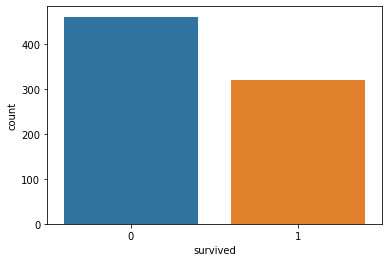
0 461
1 321
Name: survived, dtype: int64
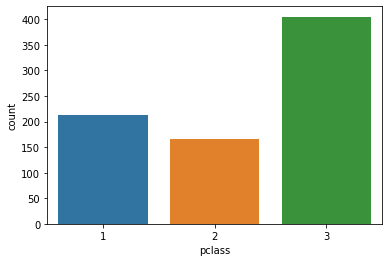
3 405
1 212
2 165
Name: pclass, dtype: int64
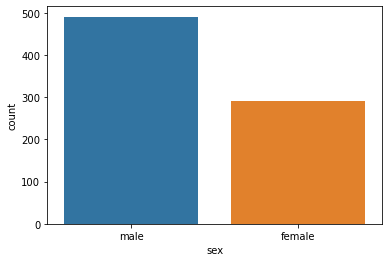
male 491
female 291
Name: sex, dtype: int64
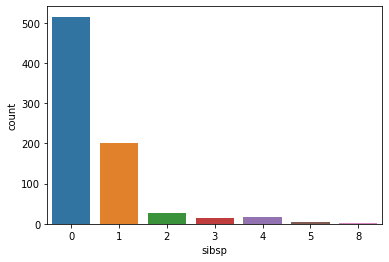
0 515
1 201
2 27
4 18
3 14
5 5
8 2
Name: sibsp, dtype: int64
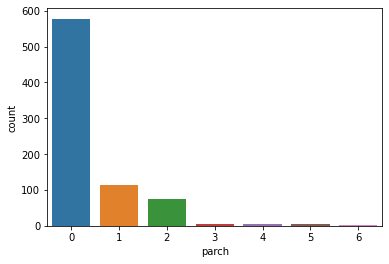
0 578
1 114
2 75
5 5
3 5
4 4
6 1
Name: parch, dtype: int64
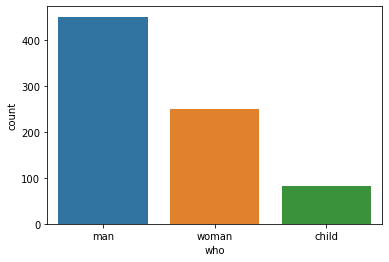
man 451
woman 249
child 82
Name: who, dtype: int64
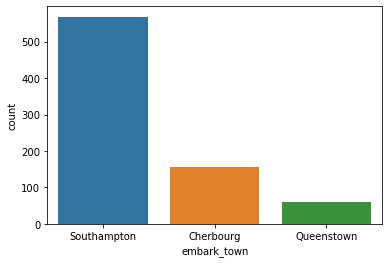
Southampton 568
Cherbourg 155
Queenstown 59
Name: embark_town, dtype: int64
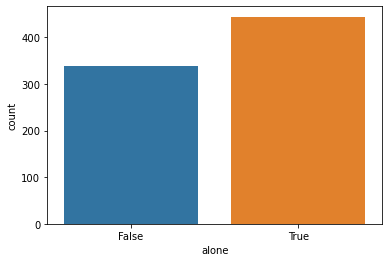
True 444
False 338
Name: alone, dtype: int64
From the above countplots, we can make the following conclusions:
Survived
461 passengers survived while 321 didnt.
Passenger Class
Majority of the passengers were in 3rd class, followed by 1st class and then 2nd class
Sex
Number of male passengers was more than female
Port of Embarkation
Majority of the passengers embarked from Southampton, followed by Cherbourg and the Queenstown
Accompanied
There were more passengers who travelled alone than with others
for i in b:
print(df[i].describe())
print(df[i].skew())
sns.distplot(df[i], kde=False)
plt.show()
count 782.000000
mean 29.700026
std 13.692729
min 0.420000
25% 22.000000
50% 29.000000
75% 36.000000
max 80.000000
Name: age, dtype: float64
0.4190340853087404
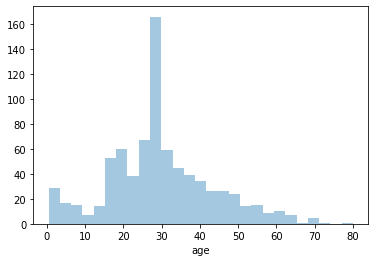
count 782.000000
mean 34.595913
std 52.176458
min 0.000000
25% 8.050000
50% 15.875000
75% 33.375000
max 512.329200
Name: fare, dtype: float64
4.583205969233933
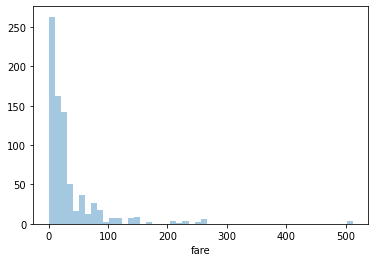
From the above countplots, we can make the following conclusions:
Age
Youngest: 0.42 (5 months)
Average age: 29
Oldest: 80
Fare
Lowest: 0 (free)
Average: 34.5
Highest: 512
The highly positive skewed data (and the info shown above) proves that 75% of the passengers paid a fare lesser than 34.
sns.swarmplot(x="survived", y="fare", data=df)
plt.show()
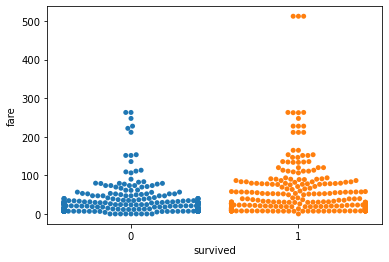
From the figure, we can come to a conclusion that there were a few set of ‘elite’ passengers who paid a very high fare, and were able to survive.
df[['pclass', 'survived']].groupby(['pclass'], as_index=False).mean()
| pclass | survived | |
|---|---|---|
| 0 | 1 | 0.627358 |
| 1 | 2 | 0.509091 |
| 2 | 3 | 0.256790 |
sns.countplot(x='pclass',hue="survived", data=df)
plt.show()
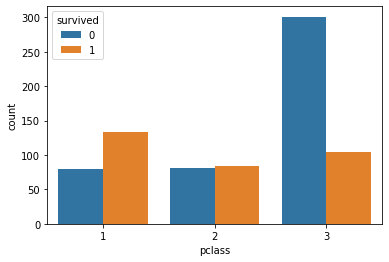
Survival rate was highest in 1st (upper) class and lowest in 3rd class.
Highest number of passengers who survived were from 1st class.
Highest number of passengers who DID NOT survive were from 3rd class.
df[['sex', 'survived']].groupby(['sex'], as_index=False).mean()
| sex | survived | |
|---|---|---|
| 0 | female | 0.738832 |
| 1 | male | 0.215886 |
sns.countplot(x='sex',hue="survived", data=df)
plt.show()
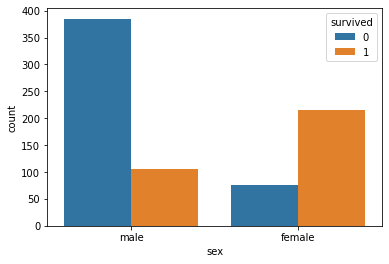
Survival rate of female passengers was more than male
age_survived = sns.FacetGrid(df, col='survived')
age_survived.map(plt.hist, 'age', bins=15)
plt.show()
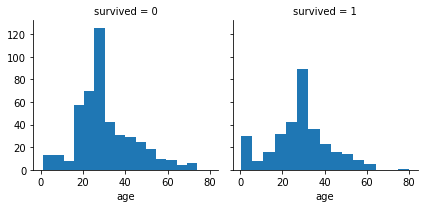
Older passengers (of around 80 years old) survived.
Machine Learning Model - Logistic Regression
# Convert Boolean to Integer
df["alone"] = df["alone"].astype(int)
df.head()
| survived | pclass | sex | age | sibsp | parch | fare | who | embark_town | alone | |
|---|---|---|---|---|---|---|---|---|---|---|
| 0 | 0 | 3 | male | 22.0 | 1 | 0 | 7.2500 | man | Southampton | 0 |
| 1 | 1 | 1 | female | 38.0 | 1 | 0 | 71.2833 | woman | Cherbourg | 0 |
| 2 | 1 | 3 | female | 26.0 | 0 | 0 | 7.9250 | woman | Southampton | 1 |
| 3 | 1 | 1 | female | 35.0 | 1 | 0 | 53.1000 | woman | Southampton | 0 |
| 4 | 0 | 3 | male | 35.0 | 0 | 0 | 8.0500 | man | Southampton | 1 |
# Encode the data (convert strings to numbers) so that the model can understand.
le_sex = LabelEncoder()
df["sex"]=le_sex.fit_transform(df["sex"])
le_who = LabelEncoder()
df["who"]=le_who.fit_transform(df["who"])
le_embark_town = LabelEncoder()
df["embark_town"]=le_embark_town.fit_transform(df["embark_town"])
print(df.shape)
df.head(10)
(782, 10)
| survived | pclass | sex | age | sibsp | parch | fare | who | embark_town | alone | |
|---|---|---|---|---|---|---|---|---|---|---|
| 0 | 0 | 3 | 1 | 22.0 | 1 | 0 | 7.2500 | 1 | 2 | 0 |
| 1 | 1 | 1 | 0 | 38.0 | 1 | 0 | 71.2833 | 2 | 0 | 0 |
| 2 | 1 | 3 | 0 | 26.0 | 0 | 0 | 7.9250 | 2 | 2 | 1 |
| 3 | 1 | 1 | 0 | 35.0 | 1 | 0 | 53.1000 | 2 | 2 | 0 |
| 4 | 0 | 3 | 1 | 35.0 | 0 | 0 | 8.0500 | 1 | 2 | 1 |
| 5 | 0 | 3 | 1 | 29.0 | 0 | 0 | 8.4583 | 1 | 1 | 1 |
| 6 | 0 | 1 | 1 | 54.0 | 0 | 0 | 51.8625 | 1 | 2 | 1 |
| 7 | 0 | 3 | 1 | 2.0 | 3 | 1 | 21.0750 | 0 | 2 | 0 |
| 8 | 1 | 3 | 0 | 27.0 | 0 | 2 | 11.1333 | 2 | 2 | 0 |
| 9 | 1 | 2 | 0 | 14.0 | 1 | 0 | 30.0708 | 0 | 0 | 0 |
# Split the dependent and independent values
x = df.drop("survived", axis=1)
y = df["survived"]
# pre-processing the data
x = StandardScaler().fit(x).transform(x)
# Split the data for training and testing
xtrain, xtest, ytrain, ytest = train_test_split(x, y, train_size=0.8)
print ('Train set:', xtrain.shape, ytrain.shape)
print ('Test set:', xtest.shape, ytest.shape)
Train set: (625, 9) (625,)
Test set: (157, 9) (157,)
# Load logistic regression model from sklearn and fit the training sets
algo = LogisticRegression().fit(xtrain,ytrain)
# find out the predictions for the testing set
ypred = algo.predict(xtest)
# compare predicted values and actual values and find out accuracy
print("Mean Absolute Error: ", mean_absolute_error(ytest,ypred))
print("Accuracy: ", accuracy_score(ytest,ypred))
Mean Absolute Error: 0.17834394904458598
Accuracy: 0.821656050955414

